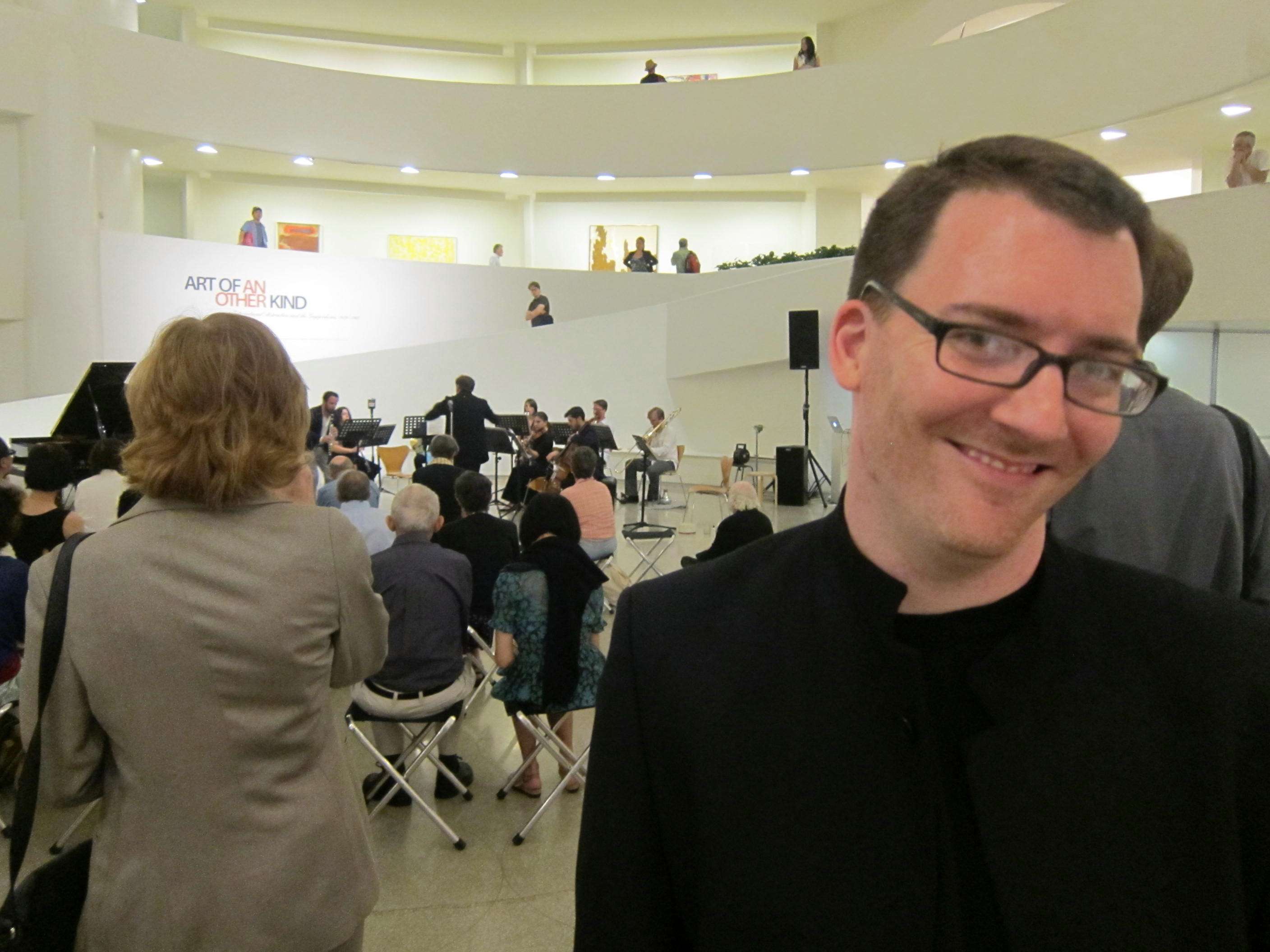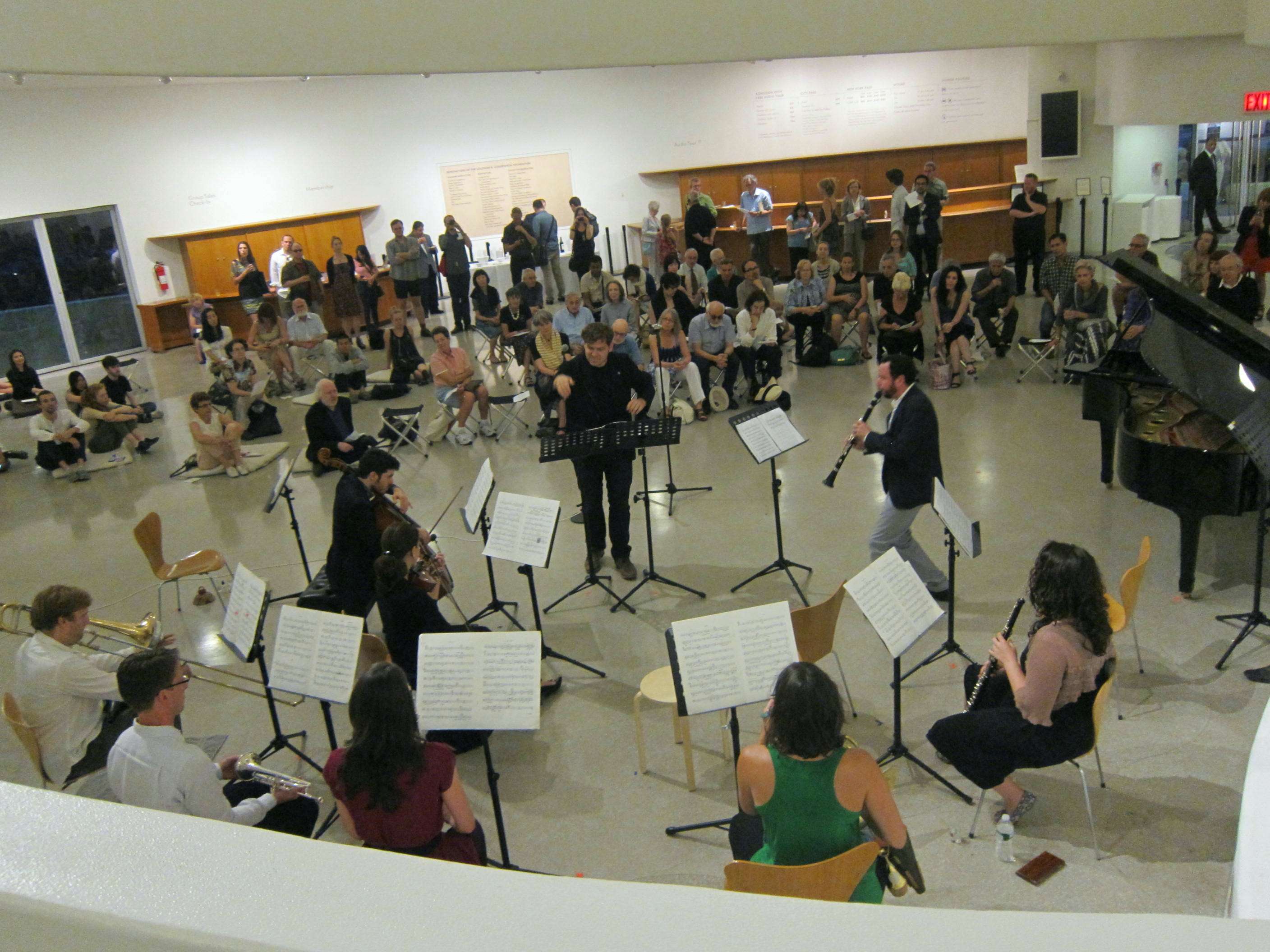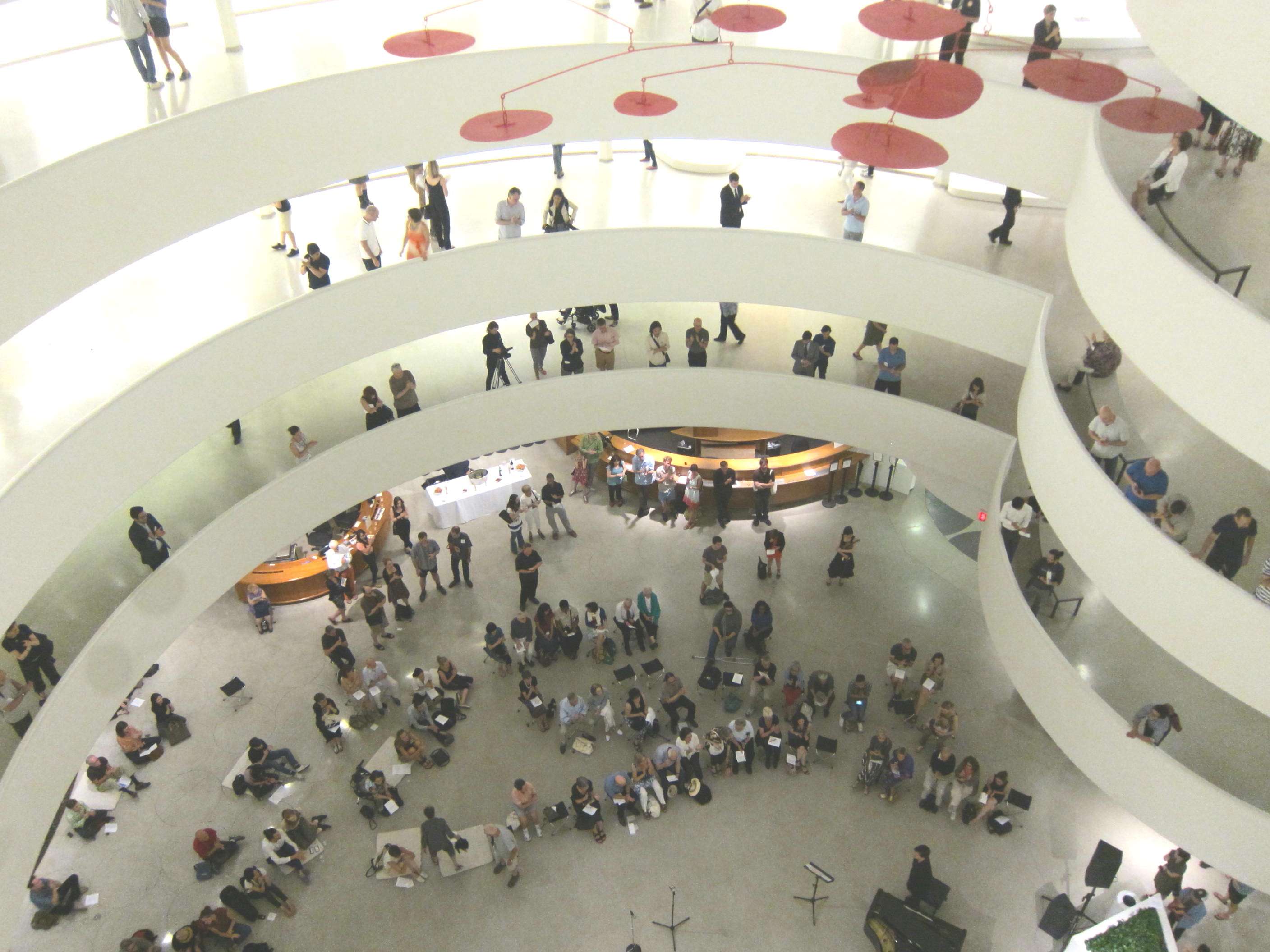|
Back
The Stochastic Audience New York
Guggenheim Museum Rotunda
07/10/2012 -
Pierre Schaeffer: Cinq Etudes de bruits
Edgard Varèse: Untitled Graphic Score (ca 1957)
Toru Takemitsu: Landscape
Earle Brown: November ’52 (Synergy) from Folio and 4 Systems
Karlheinz Stockhausen: Klavierstück XI
Morton Feldman: Projection 4 for violin and piano
Giacinto Scelsi: Kya (Movements II and III)
John Cage: Concerto for Piano with Fontana Mix (DuBois Realization)
John Rubin (Clarinet), Christa van Alstine (Bass clarinet), Gareth Flowers (Trumpet), Stephen Gosling (Piano), David Shively (Percussion), Miranda Cuckson, Cornelius Dufallo (Violins), John Popham (Cello), Christopher McIntyre (Trombone, Conductor), Ted Hearne (Conductor)
Introduction by R. Luke DuBois

R. Luke DuBois (© Coco T. Dawg)
It was the music of control and t indecision. Paintings breaking molds and classically serene. An assemblage applauding New York’s finest musicians and ignoring them, as they ascended to their own empyreans
Last night’s event at the Guggenheim Museum was almost a throwback to at 1950’s “Happening”, albeit in a Frank Lloyd Wright multi-million dollars setting. Whatever the music, it was the audience, which didn’t know where to go how to act.
And in a sense, just as this music of the Darmstadt School and beyond balanced sheer control and indeterminate movements, the spectators were part of the show, wandering or sitting, applauding or ignoring. It was all stochastic, indeterminate and fascinating for the people as much as the conception.
Mainly, last night posed posed an illogical, self-contradictory conundrum, To wit: Where is the consanguinity between painting and music? Anecdotally we can relate friendships (Feldman and Pollock), double genius (Schoenberg as composer and painter) artistic ruminations (Stockhausen lecturing on cubism). But the two arts are, let’s face, separated by every realistic boundary.
Not that composer R. Luke DuBois didn’t try. As one of the most innovative practitioners of musical videos combining sounds and graphics, he gave a pre-concert Power Point introduction introducing painters of the 1960’s generation, staring with Henry Cowell. That itself was innovative, since Cowell is rarely played these days. But he broke geographic and musical conventions. Even Bartók admired his revolutionary techniques. From there it was an easy jump to the composers who populated the–sort of–concert that ensued.
Mr. DuBois gave capsule differences between Boulez and Stockhausen, between Cage and Feldman. All of one generation and one school, yet varying as they broke all convetions. With this came images of the New York school of painting (and a very graphic video of Jackson Pollock at work to the music of Morton Feldman.)
After this, what I call the Hour of Euphoric Chaos started. Ther audience, listening attentively to Mr. DuBois, shuffled out to the Main Rotunda and didn’t know what to do. One-third sat on the floor or cushions as the musicians assembled to the “Five Studies of Noise” of Pierre Schaeffers musique concrète. One-third started to climb the ramps, to come up close to Pollock and Tàpies, Bourgeois and Calder. And one-third stood helplessly about, wondering whether to climb or listen, to gaze on the tapestries or hear New York’s great young musicians perform the most difficult music from the last half of the 20th Century.

(© Coco T. Dawg)
Initially, I was in that helpless third. Then I realized the reaction of the audience was exactly what these musics and paintings were all about. Just as Jackson Pollock conceived art to be the creation of art, just as John Cage had welcomed extraneous sounds as part of his own conception, so this audience, given no rules of behavior, faced with a plethora of gorgeous tone and colors, acted inconsistently.
Even aleatorically.
The structure of the Guggenheim was a willing accomplice to this indeterminacy. Strolling up the quarter-mile-high ramp, the musicians were seen from infinite angles. And us pilgrims ascending this man-made Holy Mountain, could look upon ourselves and our artists through concaving mirrors. We were together and apart, looking at ourselves as though over the Tibetan plateau, running into ourselves without knowing it.
To extend the image (badly), we were part of an unsuccessful Escher landscape–unsuccessful because we actually had two finishes. A beginning and an end.
The one constant was the music, which resonated over the whole rotunda with virtually the same volume. But again came the quandary. Were we supposed to hear it as background (like Mozart’s outdoor divertimenti or Satie’s “furniture music”? That was hardly likely. Not with the likes of Stephen Gosling playing Stockhausen’s 11th Piano Piece or the great trombone-conductor Christopher McIntyre booming out in Earle Brown’s work.

(© Coco T. Dawg)
But did we descend to hear the Cage? Did we climb Mount Guggenheim to reach a painted Nirvana or descend for the Cage Concerto and some wine and pretzels?? Ah, that was (in Charles Ives’ words) the unanswered question.
Last night was the second spatial happening this week, the start being the NY Phil’s event in the Armory. For the latter, we sat and inhaled the music from all sides. Here, the operation was reversed. The orchestra sat at the bottom, while we moved and were part of that space.
We, in fact, were part of a visual and auditory extravaganza. “In the room, the men and women flew...speaking of Toru Takemitsu.”
Twas a celebration, yes, of splendid musicians, glorious paintings and even (forgive this immodesty) of all us all.
Harry Rolnick
|